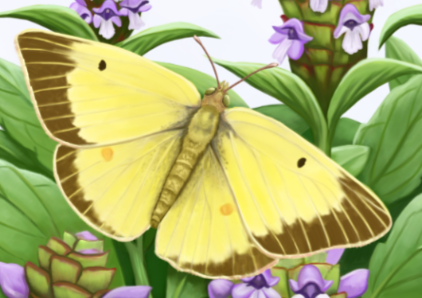the Clouded Sulphur butterfly / Colias philodice
A Butterfly Garden is a Bird-Friendly Garden
The Clouded Sulphur butterfly can be attracted to your garden by providing its larval host plants and nectar plants for the adult butterflies. Their host plants are in the pea and legume (Fabaceae) family. The Clouded Sulphur butterfly is in the Pieridae family. The Pieridae family is a large family of butterflies with 1100 species worldwide and 58 in North America.
Native Host Plants for the Clouded Sulphur Caterpillar
Host plants for the Clouded Sulphur caterpillar are in the pea and legume (Fabaceae) family. If you have a vegetable garden, you may want to plant some native perennials that are in the Fabaceae family to keep the caterpillars away from your peas and legumes. Or you could share some of your vegetable plants with them! Caterpillars play an important part in the food web. 96% of North American land birds feed insects to their young, and caterpillars are especially nutritious.
Some of the native plants in the Fabaceae family are:
Tick Trefoil (Desmodium canadense), wild Indigo (Baptisia tinctoria), Wild Senna (Senna hebecarpa), Wild Lupine (Lupinus perennis) and Self-heal (Prunella vulgaris)

Host Plant Profile – Self-heal (Prunella vulgaris)
Of these host species, Self-heal is the most widespread in North America. It is often considered a weed and dug out of our lawns when we should be doing the opposite, and digging the lawn out to make room for native plants.
Self-heal is a low perennial with a dense, cylindrical form and many purple, flowering spikes. It will grow in the sun or partial shade and should be given extra water in very dry conditions. It attracts butterflies and large numbers of native bees.
Nectar Plants for the Clouded Sulphur Butterfly
Clouded Sulphurs require a succession of nectar-bearing plants. Some of their nectar plants are fleabane (Erigeron spp.), black-eyed Susans (Rudbeckia spp.), milkweed (Asclepias spp.), asters (Symphyotrichum spp.), goldenrods (Solidago spp.), and Purple Coneflower (Echinacea purpurea).
CLOUDED SULPHUR CATERPILLARS are green when mature and have a dark stripe down their back with a whitish stripe along their side.

Clouded Sulphur Butterfly Description
The Orange and Clouded sulphur butterflies are very similar in appearance. The males have brown/black borders on their yellow wings, and the borders on the females are dotted with yellow. Occasionally, the females are white. The Clouded Sulphur has a double central spot on its hind wings and a faint row of black marginal spots.
The female Clouded can tell the difference between a male Orange and a male Clouded Sulphur because the upper wing surfaces of the Clouded absorb UV light, while the wing surface of the Orange Sulphur reflects UV light.
Wingspan: 3.8 – 7cm (1.5 – 2.75 in)

A Male Clouded Sulphur Butterfly
Broods/Flight: This species has multiple broods, three to four per year, with a flight period from May to October.
Range
The Clouded Sulphur is one of the most widespread butterflies in North America. It ranges from southern Alaska through central and southeast Canada, the Maritimes (excluding Labrador), and most of the United States.
Habitat
The Clouded Sulphur butterfly is an adaptable butterfly found in meadows, fields, roadsides, marshes, bogs ~ and gardens with the right host and nectar plants!
By planting the host and nectar plants that the Clouded Sulphur butterfly needs to complete its lifecycle, you will also provide a habitat for other pollinators.
The chrysalis is green and pointed at both ends. The Clouded Sulphur overwinters as a chrysalis.

Shelter
The Clouded Sulphur butterfly, like all butterflies, needs shelter to hide from predators and protect itself in bad weather. Shrubs, preferably native, and brush piles are great shelters for butterflies. The Clouded Sulphur caterpillar would also need shelter to form into a chrysalis.
Leave the Leaves, Sticks and Stems
Reducing your lawn, growing more native plants and leaving the leaves in your garden are important things to do in a wildlife/butterfly garden. There are many different species of insects that shelter, develop and overwinter in the leaf litter. The Clouded Sulphur overwinters as a chrysalis, attaching itself to sticks or stems. Having leaf litter and plants beneath your trees provides a soft landing and shelter for any chrysalis or caterpillar that may fall.

I find it difficult to photograph Sulphur butterflies because they never stay still for long, but I was lucky with this one as it wanted to linger on the Goldenrod. I identified this female Clouded Sulphur by its double central spots on the hind wing. At first, I thought it was a Pink-edged Sulphur because of the noticeable pink wing edges and head, but Clouded Sulphurs have pink too!
Other Sulphur Butterflies In This Blog
~ The Orange Sulphur Butterfly
~The Pink-Edged Sulphur Butterfly
A Butterfly Garden – is a pollinator/wildlife garden. Never use herbicides or pesticides anywhere near a butterfly garden.
Look but do not touch – please do not buy butterfly kits or chrysalises from commercial breeders or home-reared butterflies. This is cruel to the animals, can create unfit populations and spread diseases to the wild species.
Links to find out more about plants native to your area:
Canadian Wildlife Federation – native plant encyclopedia HERE
Ladybird Johnson Wildflower Center HERE
A great native seed house and information source is Prairie Moon Nursery – link to it HERE
*Please subscribe to this blog for more posts on butterflies and native gardening.

